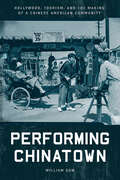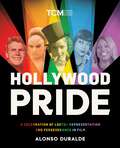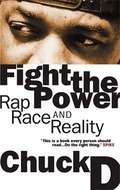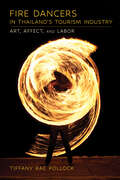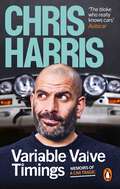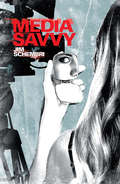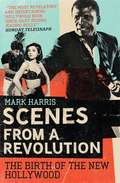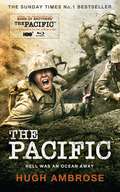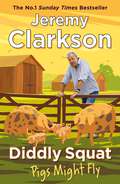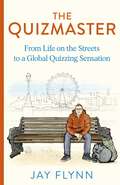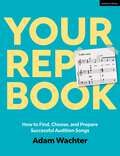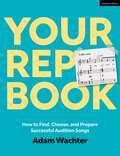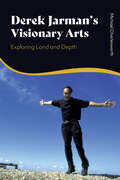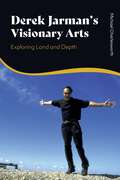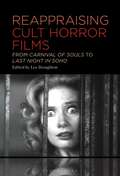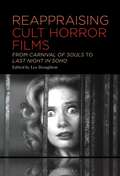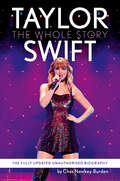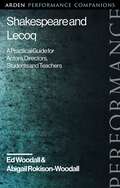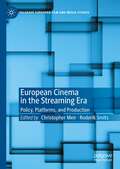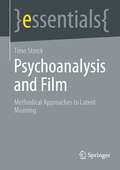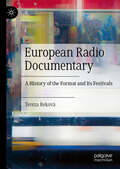- Table View
- List View
The Gothic Peckinpah
by Tony WilliamsThis book argues for the importance of Gothic in understanding one of the key elements within the films of Sam Peckinpah (1925-1984). Although occasionally noted in the past, the Gothic has been generally overlooked when most critics consider the work of Sam Peckinpah with the exception of the Freudian based Crucified Heroes (1979) by Terence Butler. This work not only examines the films made after that date, especially the often dismissed The Osterman Weekend (1983) and the two music videos he made for Julian Lennon, but also places the director within the context of the developing work on Gothic that has since appeared. Peckinpah has been identified as the director of one undisputed masterpiece, The Wild Bunch (1969). By focussing on the key role Gothic plays in most of the director’s work, this book offers a way to see Peckinpah beyond The Wild Bunch and the Western, viewing him as a director who had the potential of evolving further, had circumstances permitted, to continue his critique of American life within the developing lens of the Gothic.
Performing Chinatown: Hollywood, Tourism, and the Making of a Chinese American Community (Asian America)
by William GowIn 1938, China City opened near downtown Los Angeles. Featuring a recreation of the House of Wang set from MGM's The Good Earth, this new Chinatown employed many of the same Chinese Americans who performed as background extras in the 1937 film. Chinatown and Hollywood represented the two primary sites where Chinese Americans performed racial difference for popular audiences during the Chinese exclusion era. In Performing Chinatown, historian William Gow argues that Chinese Americans in Los Angeles used these performances in Hollywood films and in Chinatown for tourists to shape widely held understandings of race and national belonging during this pivotal chapter in U.S. history. Performing Chinatown conceives of these racial representations as intimately connected to the restrictive immigration laws that limited Chinese entry into the U.S. beginning with the 1875 Page Act and continuing until the passage of the Immigration and Nationality Act of 1965. At the heart of this argument are the voices of everyday people including Chinese American movie extras, street performers, and merchants. Drawing on more than 40 oral history interviews as well as research in more than a dozen archival and family collections, this book retells the long-overlooked history of the ways that Los Angeles Chinatown shaped Hollywood and how Hollywood, in turn, shaped perceptions of Asian American identity.
Performing Chinatown: Hollywood, Tourism, and the Making of a Chinese American Community (Asian America)
by William GowIn 1938, China City opened near downtown Los Angeles. Featuring a recreation of the House of Wang set from MGM's The Good Earth, this new Chinatown employed many of the same Chinese Americans who performed as background extras in the 1937 film. Chinatown and Hollywood represented the two primary sites where Chinese Americans performed racial difference for popular audiences during the Chinese exclusion era. In Performing Chinatown, historian William Gow argues that Chinese Americans in Los Angeles used these performances in Hollywood films and in Chinatown for tourists to shape widely held understandings of race and national belonging during this pivotal chapter in U.S. history. Performing Chinatown conceives of these racial representations as intimately connected to the restrictive immigration laws that limited Chinese entry into the U.S. beginning with the 1875 Page Act and continuing until the passage of the Immigration and Nationality Act of 1965. At the heart of this argument are the voices of everyday people including Chinese American movie extras, street performers, and merchants. Drawing on more than 40 oral history interviews as well as research in more than a dozen archival and family collections, this book retells the long-overlooked history of the ways that Los Angeles Chinatown shaped Hollywood and how Hollywood, in turn, shaped perceptions of Asian American identity.
Hollywood Pride: A Celebration of LGBTQ+ Representation and Perseverance in Film
by Alonso DuraldeFor generations, members of the LGBTQ+ community in Hollywood needed to be discreet about their lives but—make no mistake—they were everywhere, both in front of and behind the camera. On the eve of the twentieth century, in Thomas Edison&’s laboratory, one of the earliest attempts at a sound film depicted two men dancing together as a third plays the violin. It&’s only a few minutes long, but this cornerstone of early cinema captured a queer moment on film. It would not be the last. With Hollywood Pride, renowned film critic Alonso Duralde presents a history spanning from the dawn of cinema through the &“pansy craze&” of the 1930s and the New Queer Cinema of the 1990s, all the way up to today. He showcases the hard-working actors, writers, directors, producers, cinematographers, art directors, and choreographers whose achievements defined the American film industry and charts the evolution of LGBTQ+ storytelling itself—the way mainstream Hollywood decided it would portray (or erase) their lives and the narratives created by queer filmmakers who fought to tell those stories themselves. Along the way, readers will encounter a fascinating cast of characters, such as the first generation of queer actors, including J. Warren Kerrigan, Ramon Novarro, and William Haines. Early cinema pioneers like Alla Nazimova and F. W. Murnau helped shape the new medium of moving pictures. The sex symbols, both male (Rock Hudson, Tab Hunter, and Anthony Perkins) and female (Lizabeth Scott and Greta Garbo), lived under the threat of their private lives undermining their public personas. Underground filmmakers Kenneth Anger and John Waters made huge strides in LGBTQ+ representation with their off-off-Hollywood productions in the 1960s and &’70s. These screen legends paved the way for every openly queer figure in Hollywood today. Illustrated with more than 175 full-color and black-and-white images, Hollywood Pride points to the bright future of LGBTQ+ representation in cinema by revealing the story of the community&’s inclusion and erasure, its visibility and invisibility, and its triumphs and tragedies.
Fight the Power: Rap, Race and Reality with Yusuf Jah
by Chuck DChuck D, the creative force behind Public Enemy and one of the most outspoken rappers in the history of music, discusses his views on everything from rap and race to the problems with politics in society today.
Fire Dancers in Thailand's Tourism Industry: Art, Affect, and Labor
by Tiffany Rae PollockFire Dancers in Thailand's Tourism Industry explores the evolution of fire dancing from informal community jam sessions into the iconic, tourist-oriented performances at beach parties and bars, through a close consideration of the role of affect in the lives of fire dancers in the ever-changing scene. Rather than pursuing the common notion that tourism industries are exploitative enterprises that oppress workers, Tiffany Rae Pollock centers the perspectives of fire artists themselves, who view the industry as simultaneously generative and destructive. Dancers reveal how they employ affect to navigate their lives, art, and labor in this context, showcasing how affect is not only a force that acts on people but also is used and shaped by social actors toward their own ends. Fire Dancers in Thailand's Tourism Industry highlights men as affective laborers, investigating how they manage the eroticization of their identities and the intersections of art and labor in tourist economies. Exploring moments of performance and everyday life, Pollock examines how fire artists reimagine their labor, lives, and communities in Thailand's tourism industry.
Variable Valve Timings: Memoirs of a car tragic
by Chris HarrisTyre destruction, power slides and continuous droolingChris Harris has driven more cars than most people could ever dream of. His vast knowledge is legendary. He calls it 'unhinged geekery'. But we call it infectious enthusiasm, adrenaline-fueled escapism and peerless journalistic rigour and integrity.And then there are his famous skills at the wheel, from city cars to rally cars, F1 to vintage, not forgetting the Guinness World Record 3.4km sideways in an electric car.And now for the first time, Harris is going all out with that unhinged geekery, and takes us down the road of his life-long adventure with the automobile - from the Scalextric track to the Nürburgring 24 Hour, via his own formative low-powered Somerset version of The Dukes of Hazard.A highly individual, petrol-soaked life story that's all down to variable valve timings.
Media Savvy
by Jim SchembriWhile on work experience with a TV news crew, 16 year-old Cobey Miles suddenly finds herself in front of the camera covering a breaking news story about two bodies being uncovered in the ice. She proves an instant hit and her burgeoning modelling career starts to skyrocket. But when she sniffs something fishy behind the scenes at the station, Cobey realises that the story she has to tell is something certain people do not want to hear. Cobey is ultimately faced with a hard choice: leave the story alone and seize upon the success she is enjoying, or reveal the truth and risk consequences that may endanger her career – or her life. From the acclaimed author of MURDER IN AISLE 9, WELCOME TO MINUTE 16 and THE EIGHT LIVES OF STULLIE THE GREAT, Jim Schembri once again scripts a fast-paced and edgy novel, laced with humorous writing.
Scenes From A Revolution: The Birth of the New Hollywood
by Mark HarrisWith behind-the-scenes gossip creating as much drama as the movies themselves, Hollywood in 1967 showcased the future of film in more ways than one. From the anti-heroes of Bonnie and Clyde and the illicit sex of The Graduate to the race relations of In The Heat of the Night, suddenly no subject was taboo. This was a time of turbulence as hip young filmmakers embodying the restlessness and rebellion of a changing America wrought radical changes to the traditions of cinema. Scenes from a Revolution is an exceptional analysis of the films shortlisted for the Best Picture Academy Award of 1967 as well as an illuminating window into the popular culture of the time.
The Pacific (The Official HBO/Sky TV Tie-In): Hell Was An Ocean Away
by Hugh AmbroseSidney C. Philips, an easygoing Alabama teenager, enlisted along with a friend. 'Manila John' Basilone was the son of immigrants who found happiness in the rough-and-ready life of a marine. Eugene B. Sledge watched his best friend and brother go off to war - and finally rebelled against his parents to follow them. 'Shifty' Shofner was the scion of a prominent family with a long record of military service. Ensign Vernon 'Mike' Micheel left the family farm to complete flight school. Between America's retreat from China in late 1941 and the moment that MacArthur's plane landed in Japan in August 1945, these five men fought many of the key battles of the war in the Pacific. Here, Hugh Ambrose focuses on their real-life experiences and those of their fellow servicemen, enhancing and expanding upon the story told in the HBO miniseries. Covering nearly four years of combat with unprecedented access to military records, letters, journals, memoirs, photographs and interviews, this volume offers a unique historical perspective on the war against Japan, from the debacle in Bataan to the miracle of Midway, the relentless vortex of Guadalcanal, the black terraces of Iwo Jima and the killing fields of Okinawa - and ultimately the triumphant yet uneasy return home. These are the true stories of the men who put their lives on the line for their country, who were dispatched to the other side of the world to fight an enemy who preferred suicide to surrender; men who suffered hardship and humiliation in POW camps; men who witnessed casualties among soldiers and civilians alike; and men whose medals came at a shocking price - a price paid in full by all.
Diddly Squat: Pigs Might Fly
by Jeremy ClarksonGet tucked in to a third bestselling helping of Clarkson's Farm from our favourite wellie-wearing wannabe farmer, Jeremy ClarksonWelcome back to Clarkson's Farm. Since taking the wheel three years ago Jeremy's had his work cut out. And it's now clear from hard-won experience that, when it comes to farming, there's only one golden rule:Whatever you hope will happen, won't.Enthusiastic schemes to diversify have met with stubborn opposition from the red trouser brigade, defeat at the hands of Council Planning department, and predictable derision from Kaleb - although, to be fair, even Lisa had doubts about Jeremy's brilliant plan to build a business empire founded on rewilding and nettle soup. And only Cheerful Charlie is still smiling about the stifling amount of red tape that's incoming . . . But he charges by the hour.Then there are the animals: the sheep are gone; the cows have been joined by a rented bull called Break-Heart Maestro;. the pigs are making piglets; and the goats have turned out to be psychopaths.But despite the naysayers and (sometimes self-inflicted) setbacks, Jeremy remains irrepressibly optimistic about life at Diddly Squat. Because It's hard not to be when you get to harvest blackberries with a vacuum cleaner.And, after all, it shouldn't just be Break-heart Maestro who gets to enjoy a happy ending . . .Diddly Squat, Number 1 Sunday Times bestseller, October 2022
The Quizmaster: From Life on the Streets to a Global Quizzing Sensation
by Jay Flynn** Available to pre-order now **THE HEART-WARMING, REMARKABLE TRUE STORY OF THE QUIZMASTER JAY FLYNN, WHOSE VIRTUAL PUB QUIZ BECAME AN ONLINE SENSATION DURING COVID.Jay Flynn was down on his luck when the Covid pandemic struck. He had just lost the tenancy of the pub he ran in Lancashire - and with it the loyal community of locals who loved his quirky weekly quiz.As the world closed down, he sensed the quiz could now be a lifeline both for him and the locals - so he sent them invites to an online version. But he had forgotten to mark the event 'private', and on the night, a disbelieving Jay played quizmaster to half a million teams, from Kenya to Canada, New Zealand to the Ukraine. This was to be the start of a global online quiz sensation, earning more than £1 million for charity and Jay an MBE, as well as his own slot on Zoe Ball's BBC Radio 2 Breakfast Show.It was all the more incredible because, as a lost and troubled young man, Jay had spent two years homeless, sleeping on a bench on the Embankment in London, almost taking his own life. Rescued by a homeless charity, he'd learnt how a simple community can save lives. It proved a priceless lesson.Now, in his inspiring memoir, Jay shows how, sometimes, you can find the answers you're seeking in the most unexpected places.
Your Rep Book: How to Find, Choose, and Prepare Successful Audition Songs
by Adam WachterPrepping songs for Musical Theatre auditions can be more stressful and confusing than a bad production of Sweeney Todd... but this book can help. How do you find the right songs, and in all the various genres? Where do you get the sheet music? How do you edit it down to make your 16- or 32-bar cut? What even is a 16-bar cut?! Relax, diva: Your Rep Book has the answers to all these questions and so many more. Adam Wachter has taught courses on audition repertoire selection at top conservatories in the US and UK and spent years accompanying and sitting “behind the table” in auditions for everything from university programs to Broadway shows. This friendly and accessible guide is designed to answer all your questions and help you stock that rep book with tight cuts of great songs so you can walk into your next audition and totally nail it. Including a foreword by Broadway casting director Rachel Hoffman and an afterword by Broadway and West End star Caissie Levy, Your Rep Book takes its readers step-by-step through the strangely mysterious process of building your audition repertoire portfolio (or “rep book” in industry jargon). Leaving no stone – or showtune – unturned, it helps you identify what songs you need in which categories and explains where to find them, how to source and cut the sheet music, and even how to communicate effectively with the accompanist and act your song. Whether you're a high school student auditioning for college MT programs or the ink is still wet on your recent BFA, or even if you're a seasoned pro dusting off those old charts, Your Rep Book is here to help!
Your Rep Book: How to Find, Choose, and Prepare Successful Audition Songs
by Adam WachterPrepping songs for Musical Theatre auditions can be more stressful and confusing than a bad production of Sweeney Todd... but this book can help. How do you find the right songs, and in all the various genres? Where do you get the sheet music? How do you edit it down to make your 16- or 32-bar cut? What even is a 16-bar cut?! Relax, diva: Your Rep Book has the answers to all these questions and so many more. Adam Wachter has taught courses on audition repertoire selection at top conservatories in the US and UK and spent years accompanying and sitting “behind the table” in auditions for everything from university programs to Broadway shows. This friendly and accessible guide is designed to answer all your questions and help you stock that rep book with tight cuts of great songs so you can walk into your next audition and totally nail it. Including a foreword by Broadway casting director Rachel Hoffman and an afterword by Broadway and West End star Caissie Levy, Your Rep Book takes its readers step-by-step through the strangely mysterious process of building your audition repertoire portfolio (or “rep book” in industry jargon). Leaving no stone – or showtune – unturned, it helps you identify what songs you need in which categories and explains where to find them, how to source and cut the sheet music, and even how to communicate effectively with the accompanist and act your song. Whether you're a high school student auditioning for college MT programs or the ink is still wet on your recent BFA, or even if you're a seasoned pro dusting off those old charts, Your Rep Book is here to help!
Derek Jarman’s Visionary Arts: Exploring Land and Depth
by Michael CharlesworthDerek Jarman's place in the history of film is assured by virtue of his vibrant, defiant films that experiment with the very process of film-making and create new forms. His paintings, their excitements and their profundity, are less well known. Michael Charlesworth sheds light on the varied ramifications of Jarman's artistic practice from his years at Prospect Cottage, Dungeness, and provides the first book-length study of his interest in depth psychology. He draws on Jarman's paintings, especially his landscapes from the 1960s and 70s, his multiple series such as 'black' and 'broken glass', GBH, Queer and Evil Queen, and his last Ecstatic Landscapes (1991-3). He also showcases Jarman's excellence as a writer with respect to his memoir, Kicking the Pricks. In a novel approach to Jarman's cinema, selecting films such as Journey to Avebury (1973), Caravaggio (1986), The Garden (1990) and Blue (1993), Charlesworth emphasizes themes and artistry rather than narrative. Exploring the ways in which Jungian and post-Jungian psychology were absorbed into Jarman's varied works, Derek Jarman's Visionary Arts provides a fresh perspective on his painting, film and writing. It celebrates him as one of the major British artists of the late 20th century, engaging with current debates about queer sexualities, environmentalism and climate catastrophe.
Derek Jarman’s Visionary Arts: Exploring Land and Depth
by Michael CharlesworthDerek Jarman's place in the history of film is assured by virtue of his vibrant, defiant films that experiment with the very process of film-making and create new forms. His paintings, their excitements and their profundity, are less well known. Michael Charlesworth sheds light on the varied ramifications of Jarman's artistic practice from his years at Prospect Cottage, Dungeness, and provides the first book-length study of his interest in depth psychology. He draws on Jarman's paintings, especially his landscapes from the 1960s and 70s, his multiple series such as 'black' and 'broken glass', GBH, Queer and Evil Queen, and his last Ecstatic Landscapes (1991-3). He also showcases Jarman's excellence as a writer with respect to his memoir, Kicking the Pricks. In a novel approach to Jarman's cinema, selecting films such as Journey to Avebury (1973), Caravaggio (1986), The Garden (1990) and Blue (1993), Charlesworth emphasizes themes and artistry rather than narrative. Exploring the ways in which Jungian and post-Jungian psychology were absorbed into Jarman's varied works, Derek Jarman's Visionary Arts provides a fresh perspective on his painting, film and writing. It celebrates him as one of the major British artists of the late 20th century, engaging with current debates about queer sexualities, environmentalism and climate catastrophe.
Reappraising Cult Horror Films: From Carnival of Souls to Last Night in Soho
by Lee BroughtonIdentifies key – and in some cases previously overlooked – cult horror films from around the world and reappraises them by approaching and interrogating them in new ways.New productions in the horror genre occupy a prominent space within the cinematic landscape of the 21st century, but the genre's back catalogue of older films refuses to be consigned to the motion picture graveyard just yet. Interest in older horror films remains high, and an ever-increasing number of these films have enjoyed an afterlife as cult movies thanks to regular film festival screenings, television broadcasts and home video releases. Similarly, academic interest in the horror genre has remained high. The frameworks applied by contributors to the collection include genre studies, narrative theory, socio-political readings, aspects of cultural studies, gendered readings, archival research, fan culture work, interviews with filmmakers, aspects of film historiography, spatial theory and cult film theory. Covering a corpus of films that ranges from recognised cult horror classics such as The Wicker Man, The Shining and Candyman to more obscure films like Daughters of Darkness, The Legend of the 7 Golden Vampires, Shivers, Howling III: The Marsupials and Inside, Broughton has curated an international selection of case studies that show the diverse nature of the cult horror subgenre. Be they star-laden, stylish, violent, bizarre or simply little heard-of obscurities, this book offers a multitude of new critical insights into a truly eclectic selection of cult horror films.
Reappraising Cult Horror Films: From Carnival of Souls to Last Night in Soho
Identifies key – and in some cases previously overlooked – cult horror films from around the world and reappraises them by approaching and interrogating them in new ways.New productions in the horror genre occupy a prominent space within the cinematic landscape of the 21st century, but the genre's back catalogue of older films refuses to be consigned to the motion picture graveyard just yet. Interest in older horror films remains high, and an ever-increasing number of these films have enjoyed an afterlife as cult movies thanks to regular film festival screenings, television broadcasts and home video releases. Similarly, academic interest in the horror genre has remained high. The frameworks applied by contributors to the collection include genre studies, narrative theory, socio-political readings, aspects of cultural studies, gendered readings, archival research, fan culture work, interviews with filmmakers, aspects of film historiography, spatial theory and cult film theory. Covering a corpus of films that ranges from recognised cult horror classics such as The Wicker Man, The Shining and Candyman to more obscure films like Daughters of Darkness, The Legend of the 7 Golden Vampires, Shivers, Howling III: The Marsupials and Inside, Broughton has curated an international selection of case studies that show the diverse nature of the cult horror subgenre. Be they star-laden, stylish, violent, bizarre or simply little heard-of obscurities, this book offers a multitude of new critical insights into a truly eclectic selection of cult horror films.
Taylor Swift: The Whole Story
by null Chas Newkey-BurdenThe #1 New York Times Bestseller As Taylor releases her 11th album, THE TORTURED POET’S DEPARTMENT, catch up on the full story of Taylor Swift’s stratospheric rise to fame; all any dedicated Swifty needs to know about the pop superstar who’s taking over the world A small-town girl with incredible talent – and the strength and determination to realise her dream – Taylor Swift has gone from America’s sweetheart to global megastar. But how did she get there? And how has she coped with the realities of fame? Fully updated in fascinating detail, Taylor Swift: The Whole Story explores Taylor’s musical evolution and her status as a fearless businesswoman operating on her own terms. From her early beginnings in Pennsylvania to the challenges she faced on the road to success, and from her relationships with Harry Styles, Joe Alwyn and Travis Kelce to her record-breaking Eras tour, this is the unmissable account of Taylor’s journey to world domination.
Shakespeare and Lecoq: A Practical Guide for Actors, Directors, Students and Teachers (Arden Performance Companions)
by Dr Abigail Rokison-Woodall Ed WoodallThis book provides actors, directors, teachers and students with a clear, practical guide to applying the work of influential theatre practitioner Jacques Lecoq to the process of rehearsing or workshopping the Shakespeare text. Written by theatre practitioner Ed Woodall, who trained with Lecoq himself, and Shakespeare academic Abigail Rokison-Woodall, this guide begins with warm-ups and ensemble-building, and moves through explorations of the story, the world of the play, the text, character emotion, thought and physicality and staging. Lecoq's method often relies on 'play', and play is often seen as trivial or inconsequential. This book argues that the more playful you are, the more playfully you investigate your speech or scene and the more physically motivated that playfulness is, the more vital and lifelike your acting of Shakespeare will be.
Shakespeare and Lecoq: A Practical Guide for Actors, Directors, Students and Teachers (Arden Performance Companions)
by Dr Abigail Rokison-Woodall Ed WoodallThis book provides actors, directors, teachers and students with a clear, practical guide to applying the work of influential theatre practitioner Jacques Lecoq to the process of rehearsing or workshopping the Shakespeare text. Written by theatre practitioner Ed Woodall, who trained with Lecoq himself, and Shakespeare academic Abigail Rokison-Woodall, this guide begins with warm-ups and ensemble-building, and moves through explorations of the story, the world of the play, the text, character emotion, thought and physicality and staging. Lecoq's method often relies on 'play', and play is often seen as trivial or inconsequential. This book argues that the more playful you are, the more playfully you investigate your speech or scene and the more physically motivated that playfulness is, the more vital and lifelike your acting of Shakespeare will be.
European Cinema in the Streaming Era: Policy, Platforms, and Production (Palgrave European Film and Media Studies)
by Christopher Meir Roderik SmitsThis collection examines the impact of streaming platforms on European cinema. It is structured from three distinct points-of-view: the policy issues related to streaming platforms, equally at the European level and in individual countries; the impact of platforms on the circulation of European films, including some of the global players, multi-national and single-nation platforms operating in Europe; and the production activities of the platforms in the form of specific ‘original’ films. By bringing together scholars working on various national cinemas, including those of France, Spain, Britain and other countries, this collection illuminates the many ways in which the European film industry is responding to the digital revolution.Chapter 5 is available open access under a Creative Commons Attribution 4.0 International License via link.springer.com.
Psychoanalysis and Film: Methodical Approaches to Latent Meaning (essentials)
by Timo StorckThis essential is dedicated to the connection between psychoanalysis and film. Psychoanalysis is suitable for a methodically guided film viewing. This is not an application of psychoanalytical theory, but rather an application of its method of a reflected relationship to a counterpart. In this way, latent meanings can be taken into consideration and an interpretation can be developed. This essential reconstructs the possibilities of such an approach and presents existing approaches. Finally, a guideline for carrying out a film psychoanalytical interpretation is proposed. Numerous film examples serve to illustrate this.The translation was done with the help of artificial intelligence. A subsequent human revision was done primarily in terms of content.
European Radio Documentary: A History of the Format and Its Festivals
by Tereza RekováThis book studies the history and significance of radio documentaries in Europe, and the institutions that are specialized on this genre. Focused on the 50-year history of the International Feature Conference (an annual gathering of radio documentarians from around the world), the book discusses the Prix Europa, Prix Italia, the Third Coast International Audio Festival, and the HearSay Audio Arts Festival. The book tells the story of people who chose sound as their lifestyle and who spread their passion worldwide.
The Gothic Peckinpah
by Tony WilliamsThis book argues for the importance of Gothic in understanding one of the key elements within the films of Sam Peckinpah (1925-1984). Although occasionally noted in the past, the Gothic has been generally overlooked when most critics consider the work of Sam Peckinpah with the exception of the Freudian based Crucified Heroes (1979) by Terence Butler. This work not only examines the films made after that date, especially the often dismissed The Osterman Weekend (1983) and the two music videos he made for Julian Lennon, but also places the director within the context of the developing work on Gothic that has since appeared. Peckinpah has been identified as the director of one undisputed masterpiece, The Wild Bunch (1969). By focussing on the key role Gothic plays in most of the director’s work, this book offers a way to see Peckinpah beyond The Wild Bunch and the Western, viewing him as a director who had the potential of evolving further, had circumstances permitted, to continue his critique of American life within the developing lens of the Gothic.

